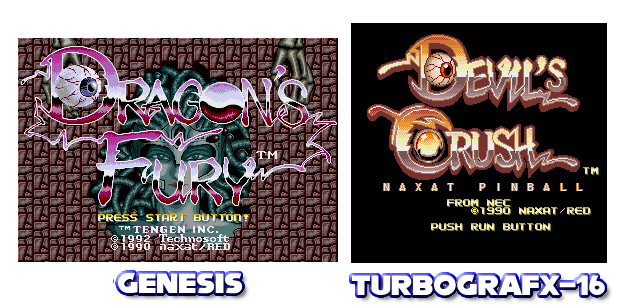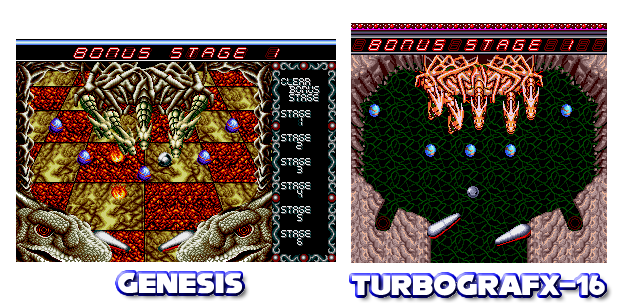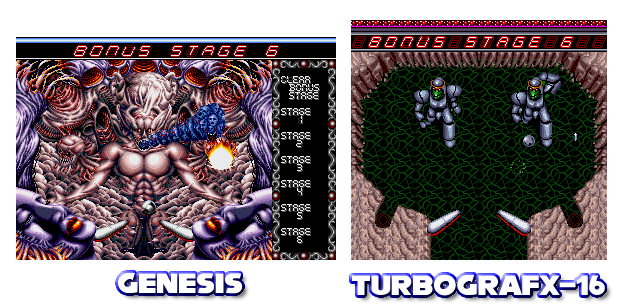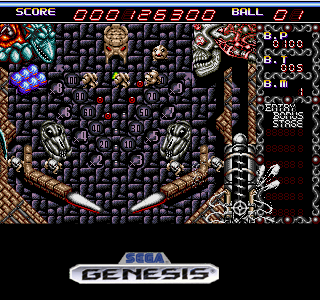Before I was awarded a Turbografx-16 system as a high school graduation present, two of the games I always wished were on the Genesis instead were Alien Crush and Devil’s Crush. Naxat made some killer pinball games (including Jaki Crush for the Super Famicom in which you must crush, yes that’s right… Jaki). When I finally played Alien Crush, I enjoyed it but was a bit underwhelmed mostly because the game refused to scroll, and it was a bit jarring going back and forth between the upper and lower halves of the board. Devil’s Crush fixed that and added lots more. The graphics were much improved, there were many more bonus stages, Noriyuki Iwadare improved his musical score at least tenfold, and the game seemed even more evil. You couldn’t do stuff like this in a real pinball game. Sign me up!
A couple of years later Mega Drive developer TechnoSoft was bored and they figured that converting Devil Crash (as it was called in Japan) would keep them busy until the new season of Beverly Hills 90210 came on the tube. Soon Devil Crash MD was released in Japan. Tengen picked it up for the US and renamed it Dragon’s Fury and actually improved the box artwork! Why they chose to call it Dragon’s Fury is beyond me, but I guess I’ll survive. Rumor has it that they also removed pentagrams from the game because they didn’t want to piss off any crazy lawyers from Florida. They also removed the Sega logo that appears when the system is first powered on and instead we get a boring Tengen logo. Oh well, no biggie I suppose. Another thing they did was make the option screen selectable instead of requiring you to hold the A button and press start like the Japanese version (and all other TechnoSoft games).
The Differences
Presentation: Both the Genesis and TurboGrafx-16 version of the game are presented with quite a lot of dark images and beasties roaming around the board. However the Sega version adds a few more bonus rooms that were completely absent in the Turbo version as well as more musical tracks. Neither version seems to have the missing pentagrams that I can find, so I assume they were both edited for the gentle, innocent and child-like American audience which in no way could ever be expected to handle such things. Scary images of demons which will haunt your nightmares, no problem. Pentagrams? Forget it! Both versions play pretty much an identical game of pinball on the main board. But overall the Sega game has a bit more substance to it so it’s going to take the edge in overall presentation.

Edge: Genesis
Graphics: This category isn’t as easy as it might seem, as both games definitely have their advantages in this area. First we must recognize that the TurboGrafx-16 version has a resolution of 256 horizontal pixels, and the game board fills this entire area and thus the whole screen. The game board on the Genesis adaptation is also 256 pixels wide, but the Genesis has a resolution that puts 320 pixels across the screen, so there was extra room for a bunch of other nonsense to the right side of the screen. Because of the extra resolution afforded by the Genesis, it makes the play area seem squished horizontally even though the playfield resolution is the same. You can see this in the animated GIF file below that shows the Genesis and TurboGrafx-16 versions superimposed over each other. Both images were taken from emulators and not resized in any way, and everyone loves animated GIFs.
TechnoSoft also went and played with the graphics a bit for the Genesis rendition, adding more detail in parts and whatnot. This makes the playfield seem more “contrasty” compared to the Turbo version. As you can see from the comparison shots, the main playfield on the Turbo looks more aesthetically pleasing to the eye even though the amount of detail is slightly decreased. And the Turbo original takes up the full screen which makes things seem larger as well, and this is another big plus in the Turbo’s favor. You’ve got to strain to see things on the Genesis version at times. But the Genesis has new bonus rounds, and some of them, like Stage six, look absolutely awesome and are not on the Turbo Grafx anywhere, at least not looking like that! This makes up for everything else in my opinion. Either way you can’t lose visually with this game, but the Genesis has enough new stuff to give it the slight edge as you can hopefully see for yourself.
Edge: Genesis
Sound/Music: This category is certainly not as cut and dry as you’d think. You can’t just say “OMFG TEH GENESIS ROXXRZ MY BOXXORZ IT IZ TEH AWSUM GENESIS WILL DESTROY U!!!!” and call it a day. Nope. If you do say that, then somebody really needs to slap you. Hard. For the music, the Turbo version was originally composed by that cool Toshiaki Sakoda guy. It sounds like your typical Turbo Grafx, with your PSG-heavy hums and buzzes. But the music is fantastic, all of it. Sakoda didn’t work on the Genesis version, TechnoSoft handled that themselves. It definitely sounds like a TechnoSoft game, but I can’t say it’s their best sound library ever. Still, it is quite awesome and has more of a stereo presence than the Turbo. TechnoSoft added a few new musical tracks for the new bonus stages as well as hidden music which you can access via the password feature. Go to the password screen and type in the following to get new music:
OMAKEBGM00 – Music from Thunder Force II
OMAKEBGM01 – Music from Herzog Zwei
OMAKEBGM02 – Music from Thunder Force III
OMAKEBGM03 – Music from Elemental Master
OMAKEBGM04 – Music from…who the hell knows? Anybody?
The Omake BGM doesn’t sound quite as nice as the games they represent, but it is a great diversion and they certainly don’t sound bad. I highly recommend OMAKEBGM03, the Elemental Master theme. If you don’t enjoy it, I will be sad.
So far it sounds like the Genesis definitely has the edge in the sound department, right? Well hold on there, Sparky… there’s more! Let’s talk sound effects. Most of them in both versions are your average fare and certainly don’t stand out in any way. Then there are the digitized sounds. When you lose a ball, you’ll get laughed at, and there are also grunts and groans when you hit a soldier with your steel ball. Believe it or not, these voices sound much better on the TurboGrafx-16. They sound a tad grainy on the Genesis. What’s more is that in typical TechnoSoft fashion ALL music and sound comes to a complete stop when the voices play. And when you loose a ball on the Genesis version, the music starts over from the beginning for some reason that my tiny brain cannot comprehend. On the Turbo Grafx-16, it keeps on playing. Still, even with these deficiencies in the Genesis version, I think it offers a slightly better sound experience overall.
Devil’s Crush: Main Theme (MP3 format, 1.3 megs) Dragon’s Fury: Main Theme (MP3 format, 1.5 megs)
Edge: Genesis
Gameplay: Both versions play pretty much exactly the same, with the Genesis having the aforementioned extra bonus stages. This isn’t a complex game by any means, and your only goal is to rollover the scoreboard which defeats all of the devils and restores peace to the entire universe, logically. I can’t really give the edge in actual play to one or the other, and I’ve played them both A LOT!

Edge: Draw
Other: The Genesis version has an options screen that features a sound test, button assignment and tilt mode options that the Turbo version simply does not have. Both have a password feature, even though I’ve never been able to earn a unique password for myself in either version. I’ve just been able to input them off of the internet or game magazines. Then again I’ve never tried to get a password. Let me try really quick; I’ll be right back…OK, I’m back. I’m sorry I was away for so long but I had to stop by the restroom. Anyway, if you pause the Genesis port and press the A button, a password will display. Super keen! The Turbo game has an interesting save feature that works if you have a Turbo Booster Plus, CD-ROM or Turbo Duo. You pause the game and navigate through a few menus to save or write down the password, and then you can resume it a few years later. Mega radical! The save abilities in each game add about one grain of nothingness to both. But the Genesis has an options screen!

Edge: Genesis
Final Assessment
OK so you have both a Sega Genesis and a TurboGrafx-16 or Turbo Duo and you want some Naxat pinball action. What to do? Well if you were me (which you’re probably not) then you’d already have both versions and love ’em lots. But some people might actually value their money. I’d recommend the Genesis version as having the most meat on its bones overall. Then again it came out nearly 2 years after the Turbo Grafx version, so you might consider this the “Director’s Cut” by a different director. It’s probably also the easiest version to find. If you want the game purely for collection reasons, then I believe the Turbo original is a bit more rare and probably worth a nickel or so more. Either way you can’t go wrong. Now go out and grab some Naxat pinball action! Just whatever you do stay far, far away from Dragon’s Revenge, the in-house Tengen sequel which has nothing to do with Naxat or TechnoSoft!


Recent Comments